10 Easy Ways to Find Great Content Topic Ideas (Step By Step)

One of the most time-consuming parts of content marketing is finding new content topic ideas to target in your blogs, discuss in your videos or post into your social media channels.
If you publish one or two pieces of content per week that’s not an issue but if you plan to scale your content marketing then you need a way to come up with new ideas fast.
Searching Google for ‘how to find content topic ideas’, you’ll get a list of articles that offer 30, 40 or 100 ways to find ideas but in reality, you don’t need that many. If you try to follow all the suggestions, you may end up losing your time.
In this guide, I’ll walk you through the 10 most efficient and easy ways to generate great content topic ideas for your blogs or any other type of content. This is how I find new ideas for my blogs that helped me increased by traffic steadily in the last 6 months.
How to Find New Content Topic Ideas
Here are the top 10 free ways to source new content ideas.
- Google Search
- Google Trends
- Topic Research Tool (SEMRush)
- Answer the Public
- Competitor Websites
- YouTube Search
- Online Courses
- Google Analytics
- Google Search Console
- UberSuggest
1. Google Search
The best tool to come up with content topic ideas is Google. Sometimes this is all you need to find new topics for your content marketing.
Google Search Suggestions
Learn how to practically build a successful website or blog.
The ONLY SEO Courseyou will ever need to read!
Go to Google.com and start typing your main topic keywords. As you type, you’ll notice that Google makes recommendations. Finish writing your main topic idea, for example, “Content marketing” and then start typing letters, starting from a letter ‘a’.

What this will give you is a combination of topics that include your main search terms and other popular keywords.
Google “Please Also Ask”
For most topics, people use Google to ask questions and Google wants to rank websites that provide answers to user’s questions.
The best way to use this feature is to try a combination of related searches and spot common topics in the “People also ask” section.
For example, if you search for ‘content marketing’ related terms, you’ll notice that in the questions, people ask ‘strategy’ related questions like “How to create a good content marketing strategy”, “What is a good content strategy” and many others.
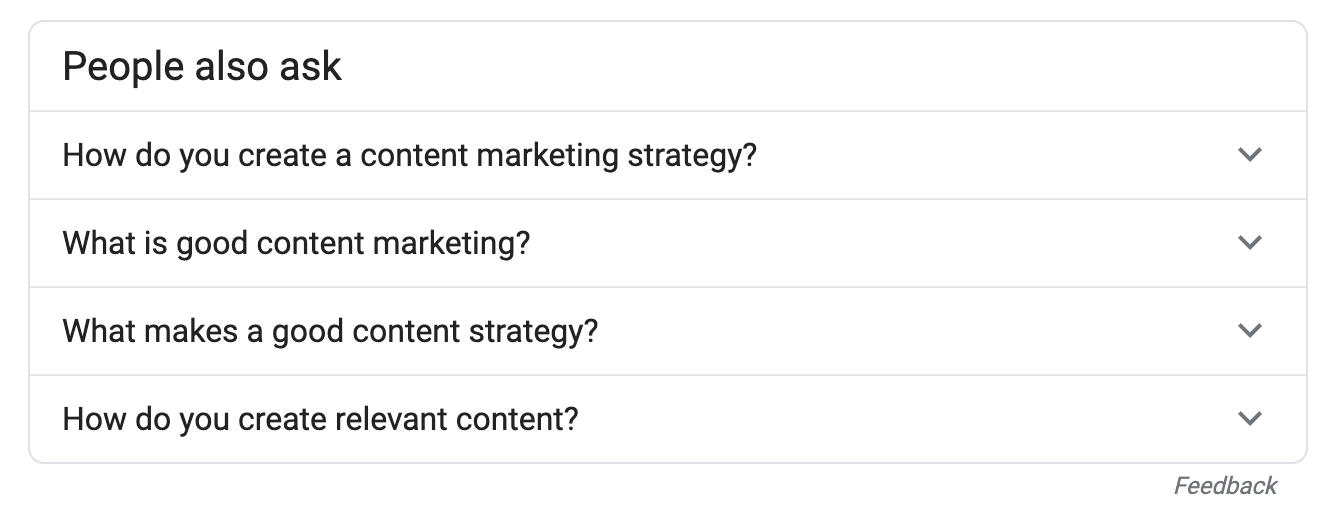
This is a good hint that ‘content marketing strategy’ is a good topic to cover in your blog either in the form of a pillar article or through topic clusters.
Google “Related Searches”
The related searches section which is located at the bottom of the page shows you topics related to your search.

For example, for “content marketing” a related topic is “content writing” so if you are already writing about content marketing, you can further expand your content by providing more content on “content writing”.
2. Google Trends
Google Trends is a great tool for researching topics and ideas but unfortunately, not a lot of people use it. In some ways, this is good because it gives you an advantage over your competitors.
The main reason to use Google trends is to find trending topics related to your niche. This is not a tool to do thorough keyword research but it can give you some hints of what ‘broad topics’ are being searched on Google.
Although the tool is easy to use, to make something out of it, you need to try a combination of searches.
As a first step, go to Google Trends and type your main topic.

You’ll notice that for most searches, Google offers you two options “search term” or “topic”. These two produce different results, so you’ll have to try both.
Start with “search term” and then repeat the process for “topic”.
Once you click Search, you’ll see that you have a number of options to narrow down your results. You can select a specific region, time period, category and type of search (Google, Youtube, Image search, etc).
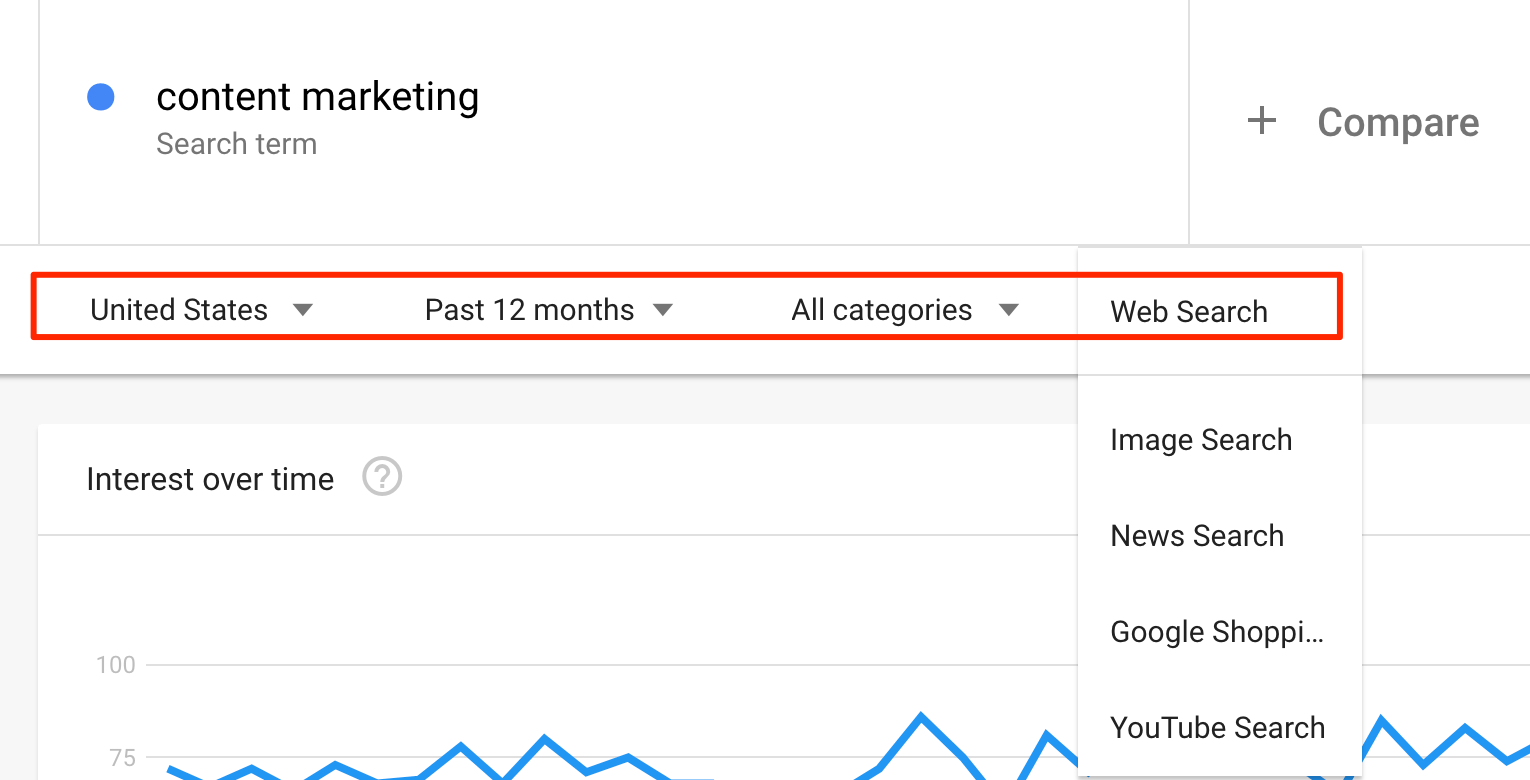
Select the filters that are most relevant to your business and niche, and scroll down to the lower part of the page.
What you want to explore more, is the RELATED QUERIES section.
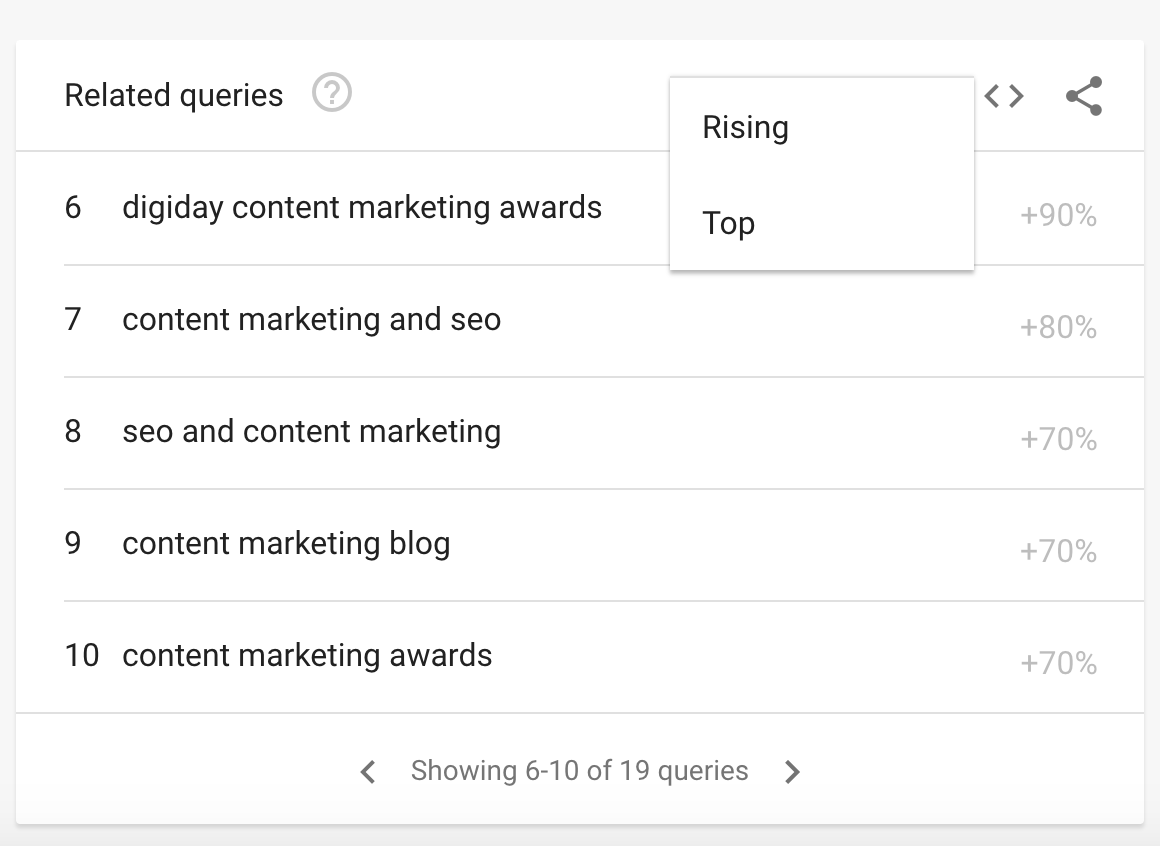
Use the left and right arrows to view all the results, and use the top menu dropdown to view both the RISING and TOP Queries.
Spot the queries that are relevant to your website and go back to Google search to find what kind of content Google shows for that topic.
Using that as your base, you can then perform thorough keyword research to find SEO keywords and long-tail keywords to use in your blogs.
3. Topic Research Tool (SEMRush)
Using a tool like SEMRUSH can help you tremendously speed up the process of finding new content topic ideas. Keyword research tools combine data from a number of sources so you don’t have to do the process manually.
SEMRUSH has a built-in feature for Topic Research. You can use to find content ideas based on search terms or based on a website (your own website or a competitor’s website).
Login to SEMRUSH and select TOPIC RESEARCH from the left menu.
Type in your main topic and click GET CONTENT IDEAS.
SEMRUSH will show you everything you need to know about the particular topic including:
- Related topics
- Most popular headlines on the topic
- Questions people ask related to the topic
- Related searches and a lot more useful information
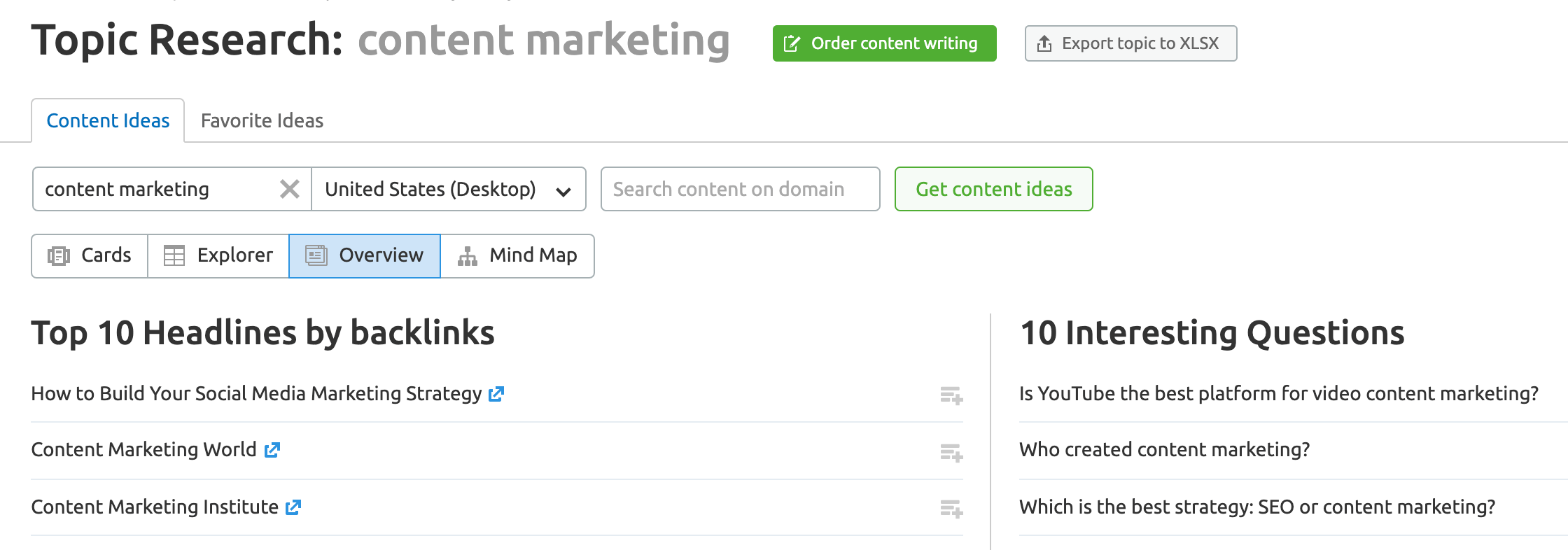
Information is organized in a very easy to use interface and there is also a “mind map”, which is a nice visual representation of all the topics related to your main idea.
You can click on any idea to drill down more and see which pages are currently ranking in Google for that topic, which keywords are used and other information.
Content Marketing Courses – SEMRUSH has a number of free courses that explain in detail how to use the topic research tool. You can find the courses on this list.
4. Answer the Public (Create affiliate account)
Another popular tool for researching content topic ideas is Answer the Public.
Answer the Public does not have all the functionality of SEMRUSH (SEMRUSH is a full digital marketing platform) but it does a good job for content marketing research.
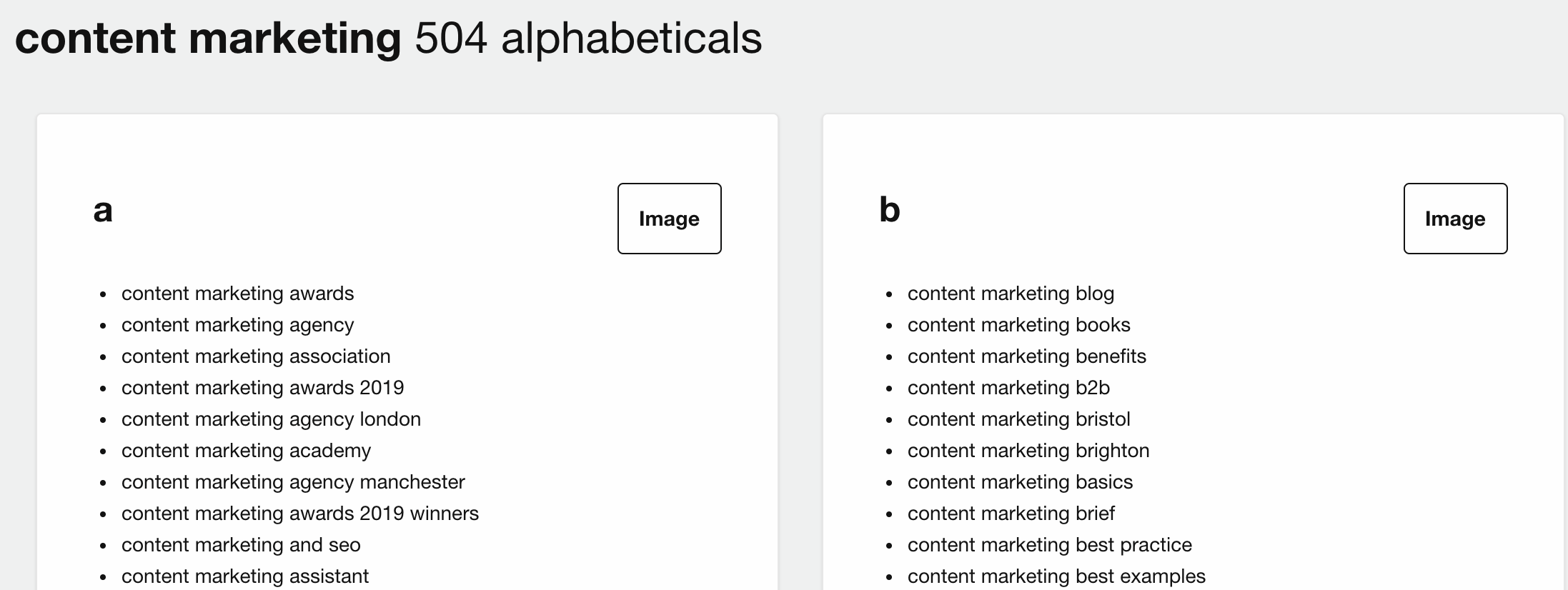
When you search for a topic, results are grouped into:
- Questions
- Prepositions
- Comparisons
- Alphabetical
- Related
The tool combines data from a number of sources and groups the related data together. It also simulates the Google and Bing autosuggest feature (as described in step 1) so you don’t have to manually repeat Google searches using different combinations.
The free version of the tool allows you to perform a few searches per day and download the data into CSV files while the paid version gives you a number of additional features like:
- Unlimited searches
- Ability to compare data for different time periods (a very useful feature to spot trends)
- Location-based results
- Saved Reports
5. Competitor Websites
To find content topic ideas in competitive niches all you have to do is spy on your competitors. They most probably already did the hard work and you can take advantage of that.
There are two ways you can use a competitor’s website to find new content ideas:
First Way: Examine their website in detail, especially their blog. Look at the topics they cover in their articles or YouTube Channel and use any of the above methods to find similar ideas you can also target.
Your goal is not to replicate their publishing schedule as is, but to use it as your main source to find ideas that are relevant to your website and users.
A good way is to register on their newsletter or use a service like Feedly to get notified every time they publish new content on their website.
Second Way: The best way to find out what topic ideas work great for your competitors is to analyze their content and rankings using a tool.
I use SEMRUSH for this task but any other tool (like Ahrefs, UberSuggest, Moz Explorer) can do the job.
By using a tool, you can find out which topics they have high rankings and which posts actually drive traffic to their websites.
The process is simple. Take their URL and enter it into SEMRUSH and then visit the ORGANIC SEARCH report.
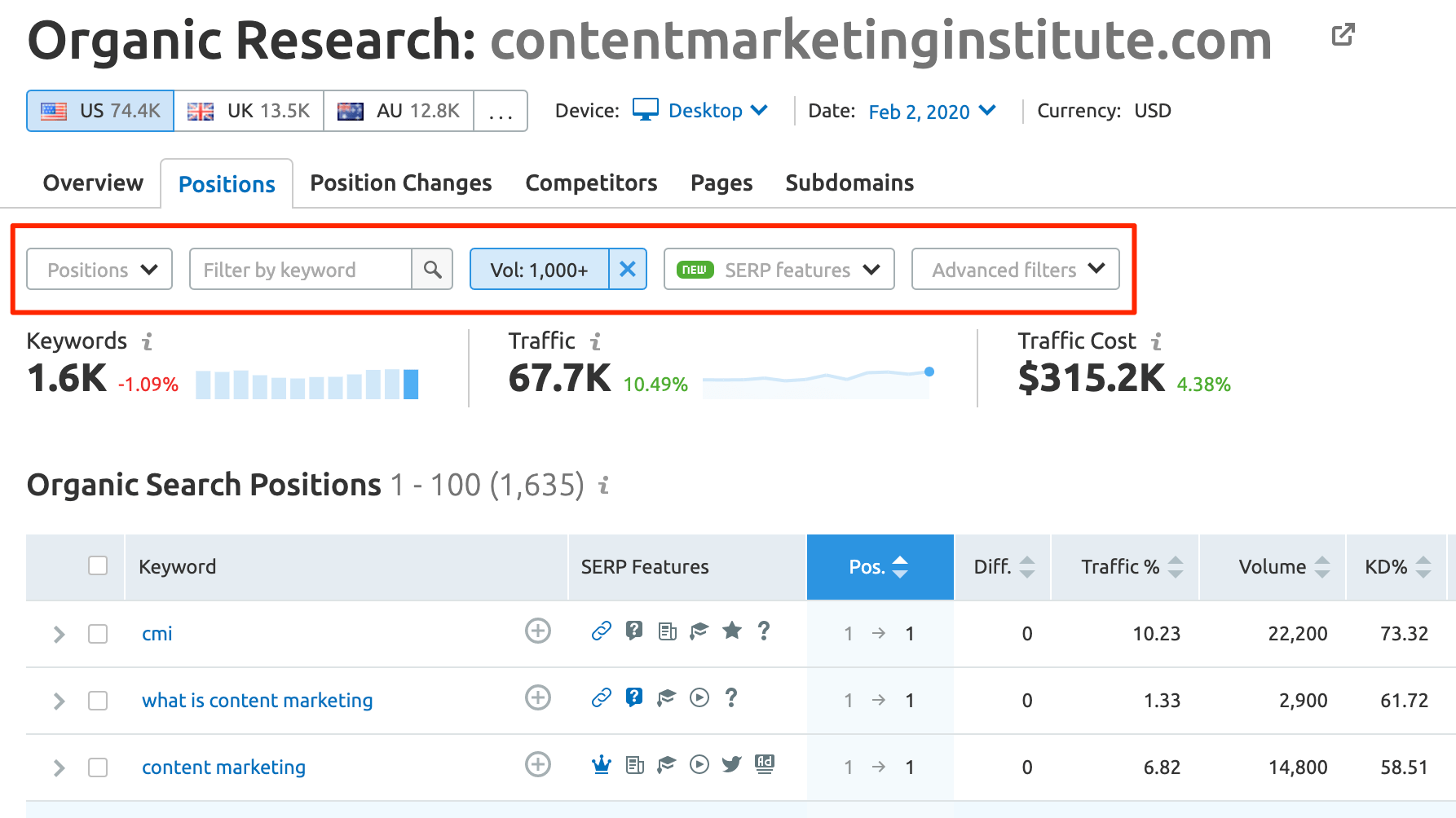
This report shows you all the keywords they are targeting together with other useful info like the ranking position, traffic, keyword difficulty and SERP features.
You can use the advanced filters to narrow down your research and concentrate only on keywords that have a decent amount of monthly traffic and generate traffic for the website.
Hint: You can use this feature to analyze the whole domain or a particular page. Find their top ranking pages and do a detailed page analysis to find keyword opportunities.
If you’re a SEMRUSH user, you can also use the KEYWORD GAP report (located under GAP ANALYSIS in the left menu), to easily find out which keywords you have in common and for which keywords they are ranking and you are not.
6. YouTube Search
Did you know that YouTube is the second most popular search engine?
Because of the nature of YouTube, people tend to ignore it when it comes to content research but it can give you a lot of useful insights into what topics people are interested in.

The process is similar to Google Search (step 1). Go to YouTube and start typing different terms in the search box and notice the suggested topics.
Analyze the videos that appear on the top positions in terms of how popular they are (views) and what topics they are targeting.
Scroll down and view the related searches section.

Try to identify topics that appear more than others and take those topics and repeat the search on Google, Google trends and your favorite research tool.
Topics you identify on YouTube can be great topics of articles as well so do this process even if you’re not publishing video content.
7. Online Courses
When we created our online SEO Course, we did thorough research to find what topics to include in our course to make it useful and interesting to users.
The topics we identified essentially became lessons of our course and this is shown in the course curriculum.
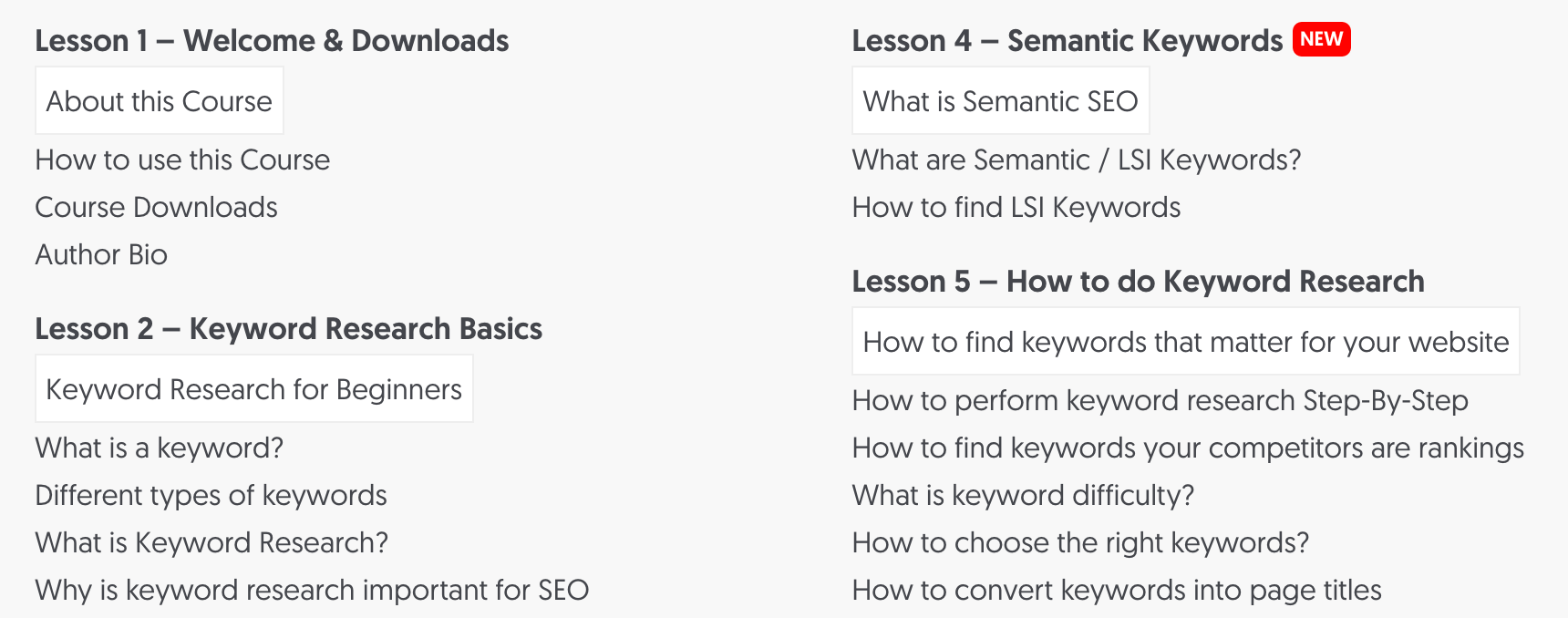
Other course providers follow the same procedure so to take advantage of this, you can find online courses related to your niche and analyze the topics they cover.
Concentrate on popular courses and on courses that were recently updated. It is more likely that their topics may have changed due to user feedback.
Popular online course platforms to continue your content topic research are:
- Udemy
- LinkedIn Learning
- Coursera
- SkillShare
8. Google Analytics
Many times you don’t need to come up with completely new content ideas but it’s more efficient to expand your content on topics that you already get traffic.
There are many advantages to doing so, the most important are:
First: You know in advance how the particular topics perform in terms of rankings and conversions. So, by publishing more related (but not identical or too similar) content you can increase your conversions.
Second: You already have authority on the topics/keywords you have high rankings and this makes it easier to rank for similar terms.
To find out content ideas using your existing content, you can use Google Analytics and Google Search Console (to be discussed in the next step).
Login to Google Analytics and navigate to the LANDING PAGE REPORT (under BEHAVIOR > SITE CONTENT > LANDING PAGES).

These are the pages that currently drive traffic to your website.
You can further drill down to filter the report by SOURCE and show only traffic from search engines (that’s organic traffic).
This will eliminate any traffic you get from social media networks that is not necessarily targeted and also exclude any paid search traffic.
Take your best-performing pages and go back to SEMRUSH (or your chosen tool) and analyze the particular page.
What you want to find out is for which keywords this page is currently ranking but most importantly for which keywords it has a ranking on the second and third pages of Google (positions 11-30).
Take those keywords (that appear in positions 11-30) and check that you don’t already have pages targeting those keywords on your site and if not, run them through Google search, semrush, answerthepublic etc to find the exact topic titles to target as new blogs.
It may sound a bit complicated but in reality, it is not. The idea is to find keywords that are related to keywords you already have a high ranking and create content to go after them.
Hint: Once you create your new content, make sure you link to it from your existing pages. This will help Google discover the new pages faster and also to pass ‘page rank’ from one page to the other.
9. Google Search Console
Google search console is a free tool provided by Google to webmasters. Among other things, it can tell you which are the most popular pages of your site in Google search and for which queries.
The concept is similar to what we did with Google Analytics above. We will use Google search console to find the popular pages of the site and topics/keywords that are related to our top pages but don’t yet have a high ranking.
Here is the process to follow:
Login to Google Search Console and click SEARCH RESULTS under PERFORMANCE (from the left menu).
Click the DATE filter on top and set the period to “Last 28 Days”.
Click on the PAGES tab.
What this report is showing is your most popular pages on Google (in terms of Clicks) for the last 28 days.
Click on each of the pages one by one to narrow your results to the particular page.
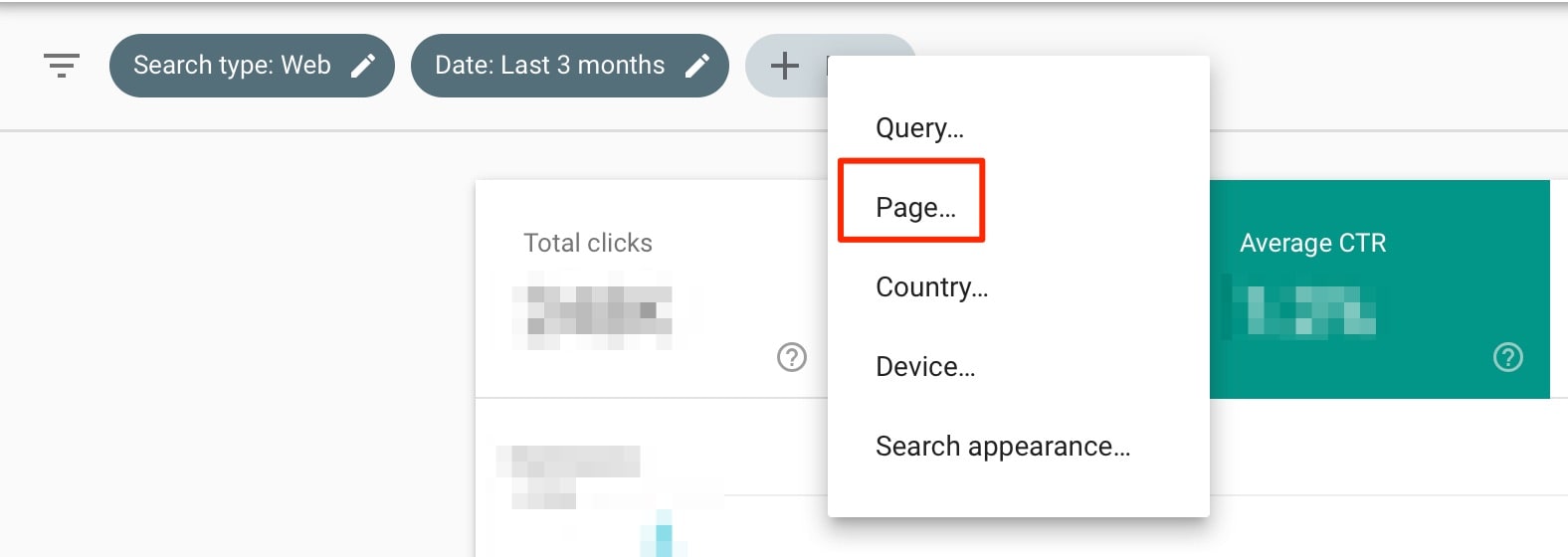
When viewing a single page, click on QUERIES. The report will not show you the particular search terms that the page is ranking on Google.
If not already activated, click the AVERAGE POSITION tab (that’s the Orange Tab) to show the average position in the report.
Scroll down and spend some time analyzing the report. Use the navigation arrows to view more results and try to spot keywords that have some clicks but their average position is > 12 (in other words they mostly appear on the second page of Google).
These are great topic ideas to target with new posts. Follow the same procedure as explained in step 8 above i..e
- Check that you don’t already have content targeting those keywords
- Create new content
- Add bi-directional internal links i.e. from existing pages to new pages and from new pages to existing pages.
Resources to Learn More about GSC
10. UberSuggest
Another free tool you can use for content marketing research is UberSuggest.
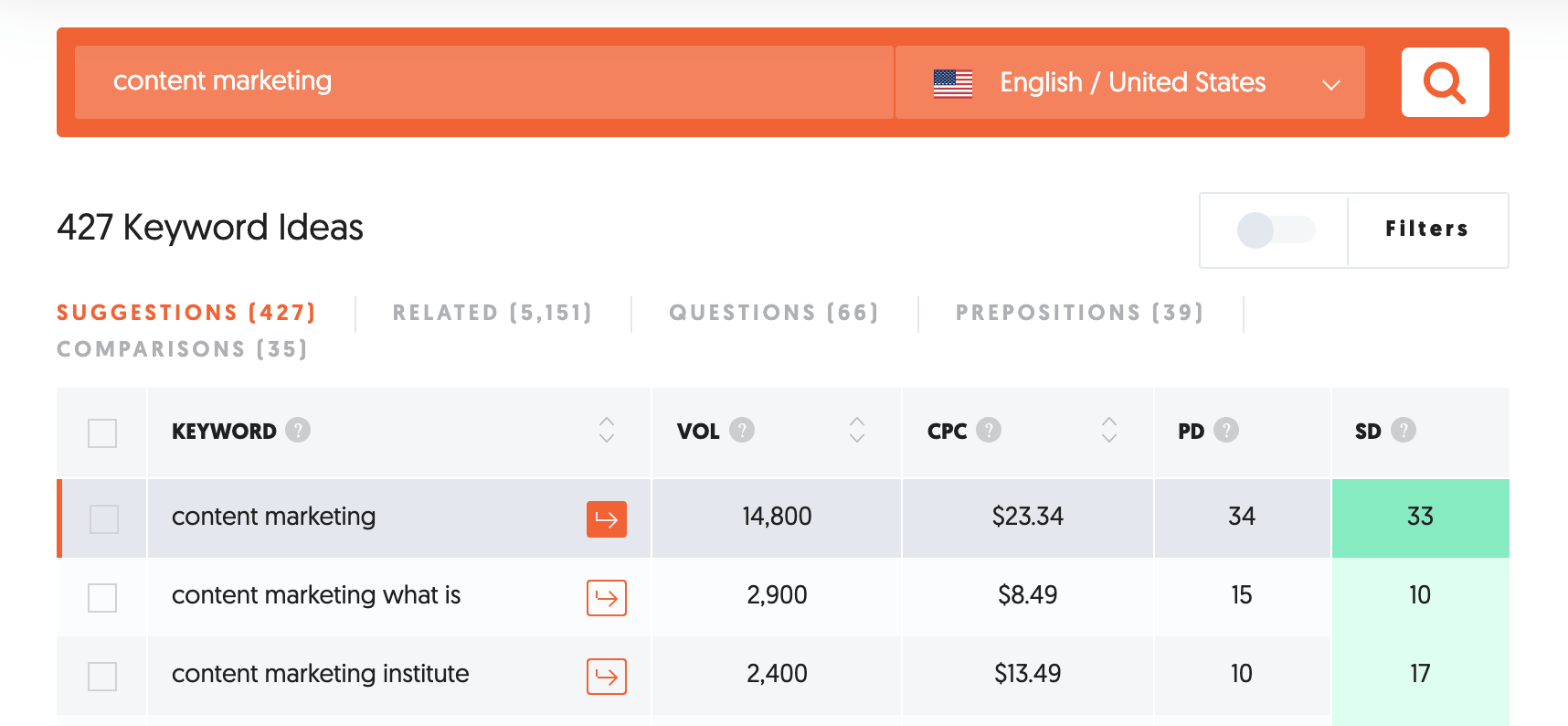
Go to UberSuggest and type in a topic.
Select CONTENT IDEAS from the left Menu.
Spot topics that have ESTIMATED TRAFFIC and SOCIAL SHARES. This combination ensures that the chosen topics will generate traffic to your site and that it’s something that users like to share on social media.
You can also click on KEYWORDS IDEAS from the left menu and get a more detailed analysis similar to SEMRUSH and Answer the Public.
Why are content ideas important for Content Marketing?
Now that you know how to find new content topic ideas, let’s quickly examine why this process is extremely important for your content marketing campaigns.
A lot of digital marketers tend to refer to the 20/80 rule when it comes to content marketing and in particular content creation.
They use it in two situations. The first it’s to stress the fact that 80% of your content will get lost in the Internet universe and never get the attention it deserves. Secondly, 20% of your content will bring in more than 80% of the traffic.
In other words, if you do everything correctly in content marketing, you can expect to get the above results. Some may say that it’s an unfair treatment but that’s how it works mainly because of the huge competition.
That’s why it is important to come up with the right topics and not waste your time on random ideas or choosing the wrong topics. If you get the topic wrong, then most likely your post or video will fail.
So, follow the above steps to not only find new ideas but to validate them using one of the tools and increase your chances of ranking high on search engines and at the same time creating content around topics that are shareable on social media networks.
Key Learnings
You don’t need to overcomplicate the content topic research process. All you have to do is make use of 4 tools:
- Google Search (including YouTube Search)
- Google Trends
- Your favorite content marketing tool
- Google Analytics and Google Search Console data.
Start with Google and Youtube search then perform the same search on Google trends. Gather some data and use your favorite tool to make a deeper analysis.
Create a list of topics that you don’t already target on your site and publish various types of content (articles, videos) to go after them.
Regularly review your Google analytics and Google search console data to find new topics that are related to topics you already rank for. Targeting these will help you increase your visibility on Google for related topics.

